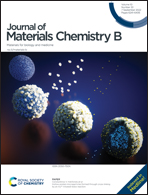Exploration of biomimetic poly(γ-benzyl-l-glutamate) fibrous scaffolds for corneal nerve regeneration†
Abstract
Poly(γ-benzyl-L-glutamate) (PBG) made biomimetic scaffolds are explored as candidate materials for corneal nerve regeneration and neurotrophic keratopathy treatment. The PBG with built-in neurotransmitter glutamate was synthesized and fabricated into 3D fibrous scaffolds containing aligned fibers using electrospinning. In in vitro experiments, primary mouse trigeminal ganglia (TG) cells were used. Immunohistochemistry (IHC) analysis shows that TG cells cultured on PBG have no cytotoxic response for 21 days. Without any nerve growth factor, TG cells have the longest neurite length of 225.3 μm in the PBG group and 1.3 times the average length as compared with the polycaprolactone and no scaffold groups. Also, aligned fibers guide the neurite growth and extension unidirectionally. In vivo assays were carried out by intracorneal implantation of PBG on clinical New Zealand rabbits. The external eye photos and in vivo confocal microscopy (IVCM) show a low immune response. The corneal neural markers (βIII tubulin and SMI312) in the IHC analysis are consistent with the position stained by glutamate of implanted scaffolds, indicating that PBG induces neurogenesis. PBG exhibits mechanical stiffness to resist material deformation possibly caused by surgical operations. The results of this study demonstrate that PBG is suitable for corneal nerve regeneration and the treatment of neurotrophic keratopathy.



 Please wait while we load your content...
Please wait while we load your content...